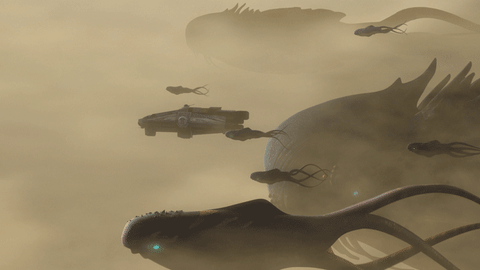
Dr. Zahl Danith, PhD in Bioorganic Communication and Nerve Signaling
Cantrell Institute of the Arts
Galactic Scientific Journal
Deep space research relays used by the Cantrell Institute of the Arts (CIA) for the Space Telemetry Analysis & Research (STAR) division have recently picked up an alarming number of new and recurring signals. These signals exhibit wavelengths all within the same frequency bandwidths of 8x10¹ to 4x10³ cycles per second, though they vary incrementally but never more than 1.2 standard deviations from the medium.
The probability density function of the accumulated datawaves has been determined to roughly follow the follow equation:

Astute statisticians will recognize this probability density function as the Weibull distribution, which has many practical applications in engineering, weather forecasting, and survival analysis. Entering the survival analysis information and the several thousand encapsulated datawaves into a local area network (LAN) composed of a T3, R2, RMD and 2X-3KPR droids with a 3PO providing the service protocol to link the four together, the droids were set upon the task of analyzing the several thousand datawaves. After 11 hours, 22 minutes, and 19 seconds, the droids outputted a list of theoretical probabilities given the data presented.
At the top of the list was the RMD’s suggestion, verified by the other droids as the most likely scenario, that these datawaves were biological communication attempts, with a total probability of 98.7% likelihood — far outpacing the R2’s second place scenario of advanced hyperdrive technology being powered by singularity at 71.6% — and so this theory was investigated first.
The STAR team reentered this selection with a linked list of known mediums, and this time entered the data into a system of datapads connected in a neural network granted holonet access. After several minutes of computation, the prime datapad reported that it had the most likely correlated reference in the medium of clouzon gas’s isotope 36. The datapad was instructed to display this reference, and it was broadcast through the main viewer:
“oooooOOOOOOOooooooo”
“OOOOOOOooooooooooo”
“oooOOOooooOOOOoooooo”
The RMD in the LAN picked up on this immediately, recognizing these as the calls and cries of cetaceans locus inanis purgillus, also known as purrgils or space whales.
This baffled the STAR team, as purrgils are not a new discovery. They’ve been classified as being pre-Republic in origin, with hearsay suggesting they may have served as inspiration for original hyperdrive technology millennia ago. However, the frequency of the reception was curious. Prior to Y21 D270, these cries would be picked up on average once per galactic month. But after this date, these cries have increased exponentially, with dozens and even hundreds identified daily. Cross-referencing this explanation for the datawaves across all of the data gathered from the relays since their construction revealed many more signals as purrgil cries. The obfuscation that occurred to obscure this previously was the absolute lack of a medium. As sound waves travel more slowly in dense mediums, so too do they travel faster through lighter mediums. Through the medium of space, the purrgil cries are distorted to such an extent that they are nearly inaudible to ears of most sentients. It wasn’t until after the population explosion that these recordings were investigated and determined to be deep-space purrgil cries.
STAR brought this information to CIA’s Wildlife Archiving & Records System (WARS) to compare the reception rates with the current estimates of the galactic purrgil population. It was a surprise to STAR / WARS that the purrgil population has indeed expanded substantially, barring the unlikely scenario of hooligans recording and broadcasting purrgil cries throughout the galaxy. The members of STAR / WARS concur that population growth is a more plausible culprit than a large-scale galactic prank.
This journal has been published galactically to inform the populace at large to be on the lookout for increasing purrgil activity and take appropriate precautions. An increase of purrgil cry reception is expected in all sectors and quadrants.
“oooooooOOOOOOOOOoooooooo”

The Cantrell Institute of the Arts is a multidisciplinary research group that spans multiple star systems and is dedicated to furthering our knowledge of the galaxy and the phenomena it hosts. The Institute is always interested in working with other researchers and helping them publish their findings. If you are interested contact the Institute's Chancellor or a government official of Ord Cantrell.














